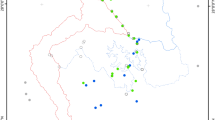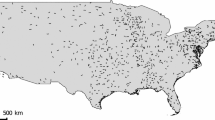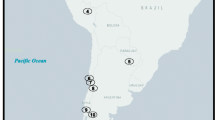Abstract
Numerous anthropogenic activities threaten the biodiversity found on earth. Because all ecological communities constantly experience temporal turnover due to natural processes, it is important to distinguish between change due to anthropogenic impact and the underlying natural rate of change. In this study, we used data sets on breeding bird communities that covered at least 20 consecutive years, from a variety of terrestrial ecosystems, to address two main questions. (1) How fast does the composition of bird communities change over time, and can we identify a baseline of natural change that distinguishes primeval systems from systems experiencing varying degrees of human impact? (2) How do patterns of temporal variation in composition vary among bird communities in ecosystems with different anthropogenic impacts? Time lag analysis (TLA) showed a pattern of increasing rate of temporal compositional change from large-scale primeval systems to disturbed and protected systems to distinctly successional systems. TLA slopes of <0.04 were typical for breeding bird communities with natural turnover, while communities subjected to anthropogenic impact were characterised by TLA slopes of >0.04. Most of the temporal variability of breeding bird communities was explained by slow changes occurring over decades, regardless of the intensity of human impact. In most of the time series, medium- and short-wave periodicity was not detected, with the exception of breeding bird communities subjected to periodic pulses (e.g. caterpillar outbreaks causing food resource peaks).



Similar content being viewed by others
References
Angeler DG, Johnson RK (2012) Temporal scales and patterns of invertebrate biodiversity dynamics in boreal lakes recovering from acidification. Ecol Appl 22:1172–1186. doi:10.1890/11-1474.1
Angeler DG, Moreno JM (2007) Zooplankton community resilience after press-type anthropogenic stress in temporary ponds. Ecol Appl 17:1105–1115. doi:10.1890/06-1040
Angeler DG, Viedma O, Moreno JM (2009) Statistical performance and information content of time lag analysis and redundancy analysis in time series modelling. Ecology 90:3245–3257. doi:10.1890/07-0391.1
Angeler DG, Drakare S, Johnson RK (2011) Revealing the organization of complex adaptive systems through multivariate time series modeling. Ecol Soc 16(3):5. doi:10.5751/ES-04175-160305
Beven G (1976) Changes in breeding bird populations of an oak-wood on Bookham Common, Surrey, over twenty-seven years. Lond Nat 55:23–42
Borcard D, Legendre P (2002) All-scale spatial analysis of ecological data by means of principal coordinates of neighbour matrices. Ecol Model 153:51–68. doi:10.1016/S0304-3800(01)00501-4
Borcard D, Legendre P, Avois-Jacquet C, Tuomisto H (2004) Dissecting the spatial structure of ecological data at multiple scales. Ecology 85:1826–1832. doi:10.1890/03-3111
Canterbury GE, Martin TE, Petit DR, Petit LJ, Bradford DF (2000) Bird communities and habitat as ecological indicators for forest condition in regional monitoring. Conserv Biol 14:544–558
Carpenter SR, Brock WA (2006) Rising variance: a leading indicator of ecological transition. Ecol Lett 9:311–318. doi:10.1111/j.1461-0248.2005.00877.x
Collins SL (2001) Long-term research and the dynamics of bird populations and communities. Auk 118:583–588. doi:10.1642/0004-8038(2001)118[0583:LTRATD]2.0.CO;2
Collins SL, Micheli F, Hartt L (2000) A method to determine rates and patterns of variability in ecological communities. Oikos 91:285–293
Dawson TP, Jackson ST, House JI, Prentice IC, Mace GM (2011) Beyond predictions: biodiversity conservation in a changing climate. Science 332:53–58. doi:10.1126/science.1200303
Diamond JM, May RM (1977) Species turnover rates on islands: dependence on census interval. Science 197:266–270
Drapeau P, Leduc A, Giroux J-FO, Savard J-PL, Bergeron Y, Vickery WL (2000) Landscape-scale disturbances and changes in bird communities of boreal mixed-wood forests. Ecol Monogr 70:423–444
Dray S (2009) pack for: forward selection with permutation (Canoco p.46). R-package version 0.0-7/r58 (with contributions of Pierre Legendre and Guillaume Blanchet). http://R-Forge.R-project.org/projects/sedar/
Dray S, Dufour AB (2007) The ade4 package: implementing the duality diagram for ecologists. J Stat Softw 22(4):1–20
Enemar A (1966) A ten-year study on the size and composition of a breeding passerine bird community. Vår Fågelvärld (Suppl) 4:47–49
Enemar A, Cavallin B, Nyholm E, Rudebeck I, Thorner AM (1994) Dynamics of a passerine bird community in a small deciduous wood, S Sweden, during 40 years. Ornis Svecica 4:65–104
Enemar A, Sjöstrand B, Andersson G, von Proschwitz T (2004) The 37-year dynamics of a subalpine passerine bird community, with special emphasis on the influence of environmental temperature and Epirrita autumnata cycles. Ornis Svecica 14:63–106
Franklin JF (1989) Importance, justification of long-term studies in ecology. In: Likens GE (ed) Long-term studies in ecology. Springer, Berlin, pp 3–19
Haffer J (1985a) Troglodytidae—Zaunkönige. In: Glutz von Blotzheim UN (ed) Handbuch der Vögel Mitteleuropas, vol 10/II. Aula-Verlag, Wiesbaden, pp 1021–1060
Haffer J (1985b) Phylloscopus collybita—Zilpzalp, Weidenlaubsänger. In: Glutz von Blotzheim UN (ed) Handbuch der Vögel Mitteleuropas, vol 12/II. Aula-Verlag, Wiesbaden, pp 1232–1292
Hall GA (1984) A long-term bird population study in an Appalachian spruce forest. Wilson Bull 96:228–240
Hansen AJ, McComb WC, Vega R, Raphael MG, Hunter M (1995) Bird habitat relationships in natural and managed forests in the West Cascades of Oregon. Ecol Appl 5:555–569
Hillebrand H, Soininen J, Snoeijs P (2010) Warming leads to higher species turnover in a coastal ecosystem. Glob Change Biol 16:1181–1193. doi:10.1111/j.1365-2486.2009.02045.x
Hobson KA, Schieck J (1999) Changes in bird communities in boreal mixed wood forest: harvest and and wildfire effects over 30 years. Ecol Appl 9:849–863
Holmes RT (1990) The structure of a temperate deciduous forest bird community: variability in time and space. In: Keast A (ed) Biogeography and ecology of forest bird communities. SPB Academic, The Hague, pp 121–139
Holmes RT (2011) Avian population and community processes in forest ecosystems: long-term research in the Hubbard Brook experimental forest. For Ecol Manage 262:20–32. doi:10.1016/j.foreco.2010.06.021
Holmes RT, Sherry TW (2001) Thirty-year bird population trends in an unfragmented temperate deciduous forest: importance of habitat change. Auk 118:589–609
Holmes RT, Sturges FW (1975) Bird community dynamics and energetics in a northern hardwoods ecosystem. J Anim Ecol 45:175–200
Holmes RT, Sherry TW, Sturges FW (1986) Bird community dynamics in a temperate deciduous forest: long-term trends at Hubbard Brook. Ecol Monogr 56:201–220
Hubbell SP (2001) The unified neutral theory of biodiversity and biogeography. Princeton University Press, Princeton
Jansen PB, de Nie HW (1986) Dertig jaar zangvogelinventarisatie in het Mastbos bij Breda. Limosa 59:127–134
Kampichler C, van der Jeugd HP (2013) Determining patterns of variability in ecological communities: time lag analysis revisited. Ecol Environ Stat 20:271–284. doi:10.1007/s10651-012-0219-y
Kendeigh SC (1982) Bird populations in East Central Illinois: fluctuations, variations, and development over a half-century. University of Illinois Press, Champaign
Korhonen JJ, Soininen J, Hillebrand H (2010) A quantitative analysis of temporal turnover in aquatic species assemblages across ecosystems. Ecology 91:508–517. doi:10.1890/09-0392.1
Lack D (1969) Population changes in the land birds of a small island. J Anim Ecol 38:211–218
Legendre P, Gallagher ED (2001) Ecologically meaningful transformations for ordination of species data. Oecologia 129:271–280
Legg CJ, Nagy L (2006) Why most conservation monitoring is, but need not be, a waste of time. J Environ Manage 78:194–198. doi:10.1016/j.jenvman.2005.04.016
Leito A, Truu J, Roosaluste E, Sepp K, Põder I (2006) Long-term dynamics of breeding birds in broad-leaved deciduous forest on Hanikatsi Island in the West-Estonian archipelago. Ornis Fenn 83:124–130
Lindenmayer DB, Likens GE (2010) The science and application of ecological monitoring. Biol Conserv 143:1317–1328. doi:10.1016/j.biocon.2010.02.013
Magurran AE, Baillie SR, Buckland ST, Dick JM, Elston DA, Scott EM, Smith RI, Somerfield PJ, Watt AD (2010) Long-term datasets in biodiversity research and monitoring: assessing change in ecological communities through time. Trends Ecol Evol 25:574–582. doi:10.1016/j.tree.2010.06.016
Oksanen J, Blanchet FG, Kindt R, Legendre P, O’Hara RB, Simpson GL, Solymos P, Stevens HH, Wagner H (2010) vegan: community ecology package. R package version 1.17-2. http://CRAN.R-project.org/package=vegan
Paradis E, Claude J, Strimmer K (2004) APE: analyses of phylogenetics and evolution in R language. Bioinformatics 20:289–290. doi:10.1093/bioinformatics/btg412
Pereira HM, Leadley PW, Proença V, Alkemade R, Scharlemann JPW, Fernandez-Manjarrés JF, Araújo MB, Balvanera P, Biggs R, Cheung WWL, Chini L, Cooper HD, Gilman EL, Guénette S, Hurtt GC, Huntington HP, Mace GM, Oberdorff T, Revenga C, Rodrigues P, Scholes RJ, Sumaila UR, Walpole M (2010) Scenarios for global biodiversity in the 21st century. Science 330:1496–1501. doi:10.1126/science.1196624
Piotrowska M, Wesołowski T (1989) The breeding ecology and behaviour of the Chiffchaff Phylloscopus collybita in primaeval and managed stands of Białowieża Forest (Poland). Acta Ornithologica 25:25–76
R Development Core Team (2011) R: a language and environment for statistical computing. http://www.R-project.org
Sanders G, Vrielink J, Kwikkel HJ, Ens S, Leys H (2001) De in de periode 1958–2000. Pennevluchten 19:71–87
Sauer J, Hines J, Fallon J (2008) The North American Breeding Bird Survey, results and analysis 1966–2007. USGS Patuxent Wildlife Research Center, Laurel
Sodhi NS, Ehrlich PR (2010) Conservation biology for all. Oxford University Press, Oxford
Steel EA, Kennedy MC, Cunningham PG, Stanovick JS (2013) Applied statistics in ecology: common pitfalls and simple solutions. Ecosphere 4:115. doi:10.1890/ES13-00160.1
Svensson S (2006) Species composition and population fluctuations of alpine bird communities during 38 years in the Scandinavian mountain range. Ornis Svecica 16:183–210
Svensson S, Carlsson UT, Liljedahl G (1984) Structure and dynamics of an alpine bird community, a 20-year study. Ann Zool Fenn 21:339–350
Svensson S, Thorner AM, Nyholm NEI (2010) Species trends, turnover and composition of a woodland bird community in southern Sweden during a period of fifty-seven years. Ornis Svecica 20:31–44
Thibault KM, White EP, Ernest SKM, White EP, Brown JH, Goheen JR (2004) Temporal dynamics in the structure and composition of a desert rodent community. Ecology 85:2649–2655. doi:10.1890/04-0321
Tiainen J (1985) Phylloscopus trochilus—Fitis, Fitislaubsänger. In: Glutz von Blotzheim UN (ed) Handbuch der Vögel Mitteleuropas, vol 12/II. Aula-Verlag, Wiesbaden, pp 1293–1357
Tomiałojć L, Wesołowski T (1994) Die Stabilität der Vogelgemeinschaft in einem Urwald der gemässigten Zone: ergebnisse einer 15jährigen Studie aus dem Nationalpark von Białowieża (Polen). Ornithologischer Beobachter 91:73–110
Tomiałojć L, Wesołowski T (1996) Structure of a primaeval forest bird community during 1970s and 1990s (Białowieża National Park, Poland). Acta Ornithol 31:133–154
Tomiałojć L, Wesołowski T, Walankiewicz W (1984) Breeding bird community of a primaeval temperate forest (Białowieża National Park, Poland). Acta Ornithol 20:241–310
van Ommering G, van der Salm JNC (1990) Ontwikkelingen in de broedvogelbevolking van Meijendel. Mededeling van het Meijendel Comité, New Series 115. Bureau Duin + Kust, Leiden
Wesołowski T (2011) Blackcap Sylvia atricapilla numbers, phenology and reproduction in a primeval forest—a 33-year study. J Ornithol 152:319–329. doi:10.1007/s10336-010-0585-x
Wesołowski T, Cholewa M (2009) Climate variation and birds’ breeding seasons in a primeval temperate forest. Clim Res 38:199–208
Wesołowski T, Rowiński P (2012) The breeding performance of Blue Tits Cyanistes caeruleus in relation to the attributes of natural holes in a primeval forest. Bird Study 59:437–448
Wesołowski T, Tomiałojć L (1997) Breeding bird dynamics in a primaeval temperate forest: long-term trends in Białowieża National Park (Poland). Ecography 20:432–453
Wesołowski T, Tomiałojć L, Mitrus C, Rowiński P, Czeszczewik D (2002) Breeding bird community of a primaeval temperate forest (Białowieża National Park, Poland) at the end of 20th century. Acta Ornithol 37:27–45
Wesołowski T, Rowiński P, Mitrus C, Czeszczewik D (2006) Breeding bird community of a primeval temperate forest (Białowieża National Park, Poland) at the beginning of the 21st century. Acta Ornithol 41:55–70. doi:10.3161/000164506777834714
Wesołowski T, Rowiński P, Maziarz M (2009) Wood warbler Phylloscopus sibilatrix—a nomadic insectivore in search of safe breeding grounds? Bird Study 56:26–33. doi:10.1080/00063650802681540
Wesołowski T, Mitrus C, Czeszczewik D, Rowiński P (2010) Breeding bird dynamics in a primeval temperate forest over thirty-five years: variation and stability in the changing world. Acta Ornithol 45:209–232. doi:10.3161/000164510X551354
Wiens JA (1989) The ecology of bird communities, vol 2. Cambridge University Press, Cambridge
Acknowledgments
Our thanks to the Vogelwerkgroep Meijendel (in particular to J.C.P. Westgeest) who placed the data from the Meijendel Dunes, The Netherlands, at our disposal, and to H. de Nie and G. Sanders for providing their data from Mastbos and Hoekelum Manor, respectively. Research on the bird community at the Hubbard Brook site was funded by grants from the US National Science Foundation and the data are available at http://www.hubbardbrook.org. We are grateful to Anders Enemar for comments on an earlier version of the manuscript. This is NIOO publication 5622.
Author information
Authors and Affiliations
Corresponding author
Additional information
Communicated by Ola Olsson.
Electronic supplementary material
Below is the link to the electronic supplementary material.
Online Resource 1 Detailed description of studied systems.
Online Resource 2 Short guide to redundancy analysis (RDA) with principal coordinates of neighbourhood matrices (PCNM).
Online Resource 3 Time lag analysis results of all breeding bird communities included in the analysis, showing the Hellinger distances between all pairs of years at different time lags and the fitted regression line. See Table 2 in the main document for statistical parameters of the regression.
Online Resource 4 Results of redundancy analyses with principal coordinates of neighborhood matrices (lc score plots) of all breeding bird communities included in the analysis. See Table 2 in the main document for statistical parameters of the analysis.
Online Resource 5 Significant principal coordinates of neighborhood matrices (PCNM) for all breeding bird communities included in the analysis. The PCNM are characterised by their wavelengths, expressed in years.
Online Resource 6 Methods applied to compare TLA and RDA-PCNM results among bird communities.
Online Resource 7 RDA-PCNM biplots of all breeding bird communities included in the analysis. No RDA models could be fitted to Kraipe plot K1, Białowieża National Park plot CM, Mastbos and Gaudineer Knob. See Online Resource 2 for an explanation of how to read an RDA-PCNM biplot.
Rights and permissions
About this article
Cite this article
Kampichler, C., Angeler, D.G., Holmes, R.T. et al. Temporal dynamics of bird community composition: an analysis of baseline conditions from long-term data. Oecologia 175, 1301–1313 (2014). https://doi.org/10.1007/s00442-014-2979-6
Received:
Accepted:
Published:
Issue Date:
DOI: https://doi.org/10.1007/s00442-014-2979-6




